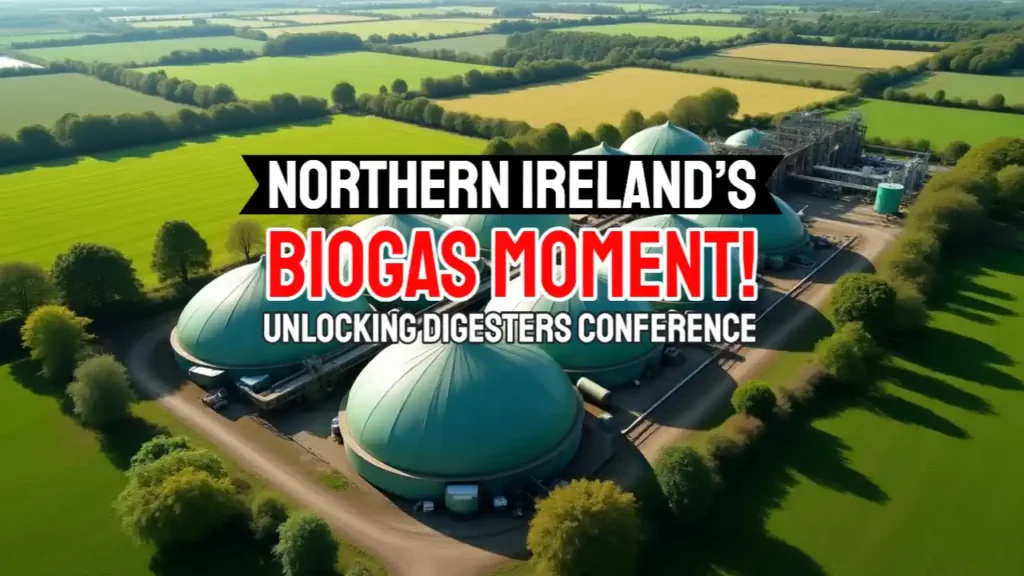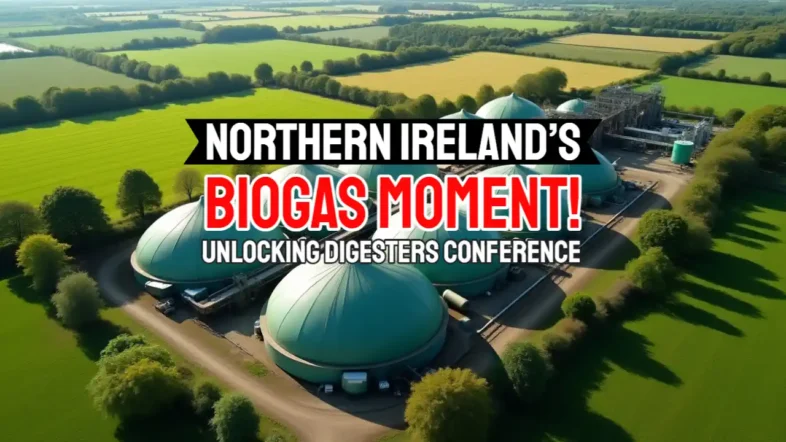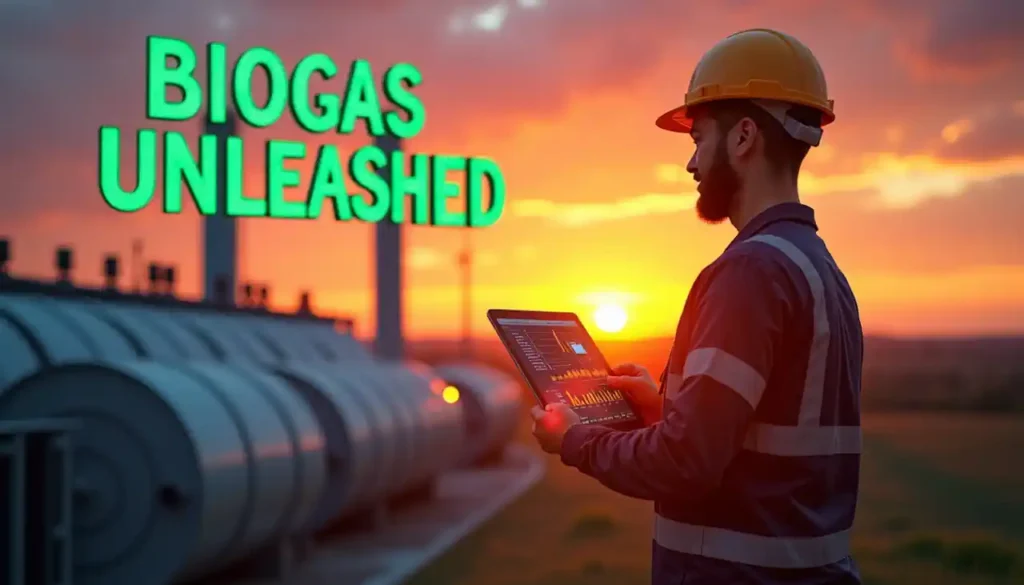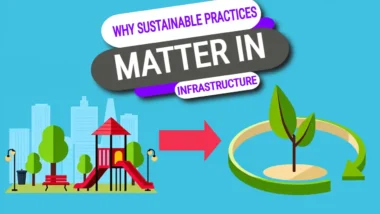A conference in NI in just a few days time will address unlocking biogas in Northern Ireland and why biogas matters for Northern Ireland’s climate and water.
Northern Ireland has the perfect recipe for producing biogas via the anaerobic digestion (AD) process: a cool, wet climate that grows grass like a factory, and a world-class dairy and beef sector generating a steady year-round waste feedstock. AD turns those abundant grasses and slurries into biogas/biomethane, slashes methane from manure storage, and crucially keeps nutrients out of rivers and loughs by converting them into value-added fertilisers.
That matters right now. Blue-green algae reappeared across NI again this summer — including Lough Neagh, where blooms were confirmed in April and persisted through July and August, even forcing a bank-holiday bathing ban at Benone Strand on the North Coast. Authorities continue to log confirmed algae locations weekly, underlining how persistent nutrient pressures remain.
AD is part of the fix when it’s paired with better nutrient management. NI already has proof points:
Granville Eco Park delivered NI’s first biomethane grid injection, showing how local organic resources can displace imported gas and close loops for food-waste and farm nutrients.
Tully Biogas (Ballymena) has long demonstrated large-scale digestion of poultry litter, producing renewable energy and concentrated ammonium fertiliser — reducing pressure to spread raw manures.
AFBI/DAERA research on digestate separation and nitrogen recovery shows how AD, coupled with ammonia stripping and mechanical separation, can retain nitrogen as marketable fertiliser while reducing emissions and runoff risk — exactly what’s needed under NI’s Nutrients Action Programme (NAP).
With algal blooms recurring and NAP tightening, the timing is right to unblock quality AD projects that turn grass and slurry into clean energy — and nutrients into products instead of pollution.
That leads us to recommending the most recent ADBA Press Release about their 2025 NI conference – after reading it. Book your place now and use the coupon code (COMMUNITY10) for 10% off. The full PR is copied below:
Conference to Address How to Unlock Biogas in NI
ADBA PR – 12 September 2025 — Alasdair Rogers
The annual conference organised by the Anaerobic Digestion and Bioresources Association (ADBA) returns to the ICC Belfast on 23 September.
Andrew Muir MLA, Minister of Agriculture, Environment and Rural Affairs at the Department of Agriculture, Environment and Rural Affairs (DAERA), Northern Ireland Executive, will, for the second year running, provide the keynote address – illustrating the ongoing support of the Northern Ireland Assembly for a successful deployment of the anaerobic digestion and biogas technology in the region.
Chris Huhne, Chair of ADBA and former Secretary of State for Energy and Climate Change, said:
“Across Northern Ireland, the AD sector is ready to lead a new energy future – but projects are stuck in limbo and optimism is fading. This conference is a chance to change that. We’ll shine a spotlight on what’s working, tackle what’s not and unlock the power of biogas to move forward.”
Northern Ireland’s AD sector holds transformative potential for clean energy, smarter nutrient management, rural economic growth, and meaningful climate action. Yet despite strong recognition of its promise, progress has stalled, meaning many projects remain undeveloped, and momentum has faded since the milestone first gas grid injection at Granville Eco Park.
Chaired by Chris Huhne, the conference will provide insights on:
What is currently holding the sector back in Northern Ireland, and how to restore the momentum
local projects that have overcome common challenges around planning, feedstock, and finance.
The role of AD in nutrient management, looking at how policy and planning can support responsible delivery and new developments such as DAERA’s Nutrients Action Programme.
International case studies with similarities to Northern Ireland – focusing on integrated delivery, public-private coordination, and strategic infrastructure.
Financing AD in Northern Ireland and what makes a strong case for investors
How to improve performance, reduce downtime, and future-proof AD plants through automation, better feedstock management, and smart technology

Confirmed speakers, alongside the ADBA policy team, include:
Mark Stevenson, Director of Regulation, Firmus Energy
Jack Blakiston-Houston, Director, BH Estates
Dr Gary Lyons, Senior Scientific Officer, Agri-Food and Bioscience Institute (ADBI)
Owen Elson, Business Development Manager, SGN
Charles McAllister, Director, Green Gas Taskforce
Stephen Robb, Renewables Editor, Irish Farmer’s Journal
Richard O’Loughlin, Vogelsang Ireland Technical Biogas Consultant
Dr James Young, Technical Lead, Centre for Competitiveness
(1) Site visits to two AD plants will be organised by ADBA on 22 September – the day before the conference. Please contact Montana Hull at montana.hull@adbioresources.org to find out more and register.
– ENDS –
For further information and to request your media accreditation, contact:
Jocelyne Bia, Head of Corporate Communications, PR and Brand Management
Jocelyne.bia@adbioresources.org | ☎ 020 3176 0592
Why is Northern Ireland Biogas such a Big Deal!
AD in Northern Ireland’s Wet Climate: Grass, Slurry, and Energy Potential
Grass growth potential: NI’s mild, wet climate supports multi-cut grass silage, giving reliable feedstock volumes that pair well with slurry.
Farm integration: Co-digesting slurry + grass silage reduces methane from open slurry storage and produces nutrients in more controllable forms.
Digestate innovation: NI research is advancing nutrient separation and N recovery technologies to meet new ammonia and water-quality rules.
Stopping Algae Blooms: How Biogas Cuts Nutrients in NI’s Loughs
The problem: Lough Neagh and connected catchments suffered cyanobacteria blooms again in 2025, with dozens of detections and a beach closure at Benone.
The solution: AD stabilises manures, enables nutrient recovery, and reduces land-spreading of raw slurry — shrinking runoff risks under NAP regulations.
Case Studies: Granville Eco Park, Tully Biogas, and Beyond
Granville Eco Park → NI’s first biomethane grid injection.
Tully Biogas → large-scale digestion of poultry litter, producing both renewable energy and concentrated ammonium fertiliser.
Farm cluster models → potential for small-to-medium farms to co-develop shared plants, cutting costs and improving nutrient balance.
Policy Drivers: DAERA, the Nutrients Action Programme, and COP Pledges
Nutrients Action Programme (NAP) 2025 refresh tightens manure and fertiliser spreading rules.
COP26 and COP28 methane pledges push NI toward faster adoption of methane reduction strategies.
NI Executive commitment → visible through DAERA support and events like this conference.

FAQs About Biogas in Northern Ireland
Q1: What is anaerobic digestion (AD) and how does it help NI?
AD turns grass, slurry, and food waste into renewable biogas/biomethane and fertiliser products. In NI’s wet, grass-rich climate, it provides energy security and reduces nutrient pollution.
Q2: Can AD fix algae blooms on its own?
Not alone — but AD + digestate processing + precision spreading reduces runoff risks compared with spreading raw slurry.
Q3: What recent evidence shows the algae problem is urgent?
2025 saw new Lough Neagh blooms and a Benone beach closure. DAERA continues weekly mapping.
Q4: Do we have NI case studies that point the way?
Yes: Granville Eco Park (first biomethane grid injection) and Tully Biogas (poultry litter to energy + fertiliser).
Q5: How does AD reduce nutrient emissions to water?
By stabilising manures, enabling solid–liquid separation and nutrient recovery, and allowing precision field application.
Q6: What policies are driving change?
NI’s Nutrients Action Programme (NAP) 2025 refresh and global methane reduction pledges.
Q7: Which feedstocks are most viable in NI?
Grass silage and cattle slurry, with poultry litter and food waste where available.
Q8: Can biomethane really go into NI’s gas grid?
Yes. The first injection went live in 2023, proving compatibility with NI’s gas network.
Northern Ireland Biogas – Conclusion
Northern Ireland’s biogas sector is ready: abundant grass, available slurries, proven projects, and urgent water-quality drivers. By pairing AD with smart nutrient recovery, NI can clean up loughs, cut farm emissions, and produce home-grown gas — delivering exactly what communities, regulators, and investors are demanding.





